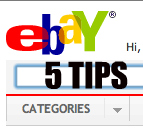Where does your old notebook go when it falls off the table and starts humming? How about that 6-month-old phone that just isn’t cool anymore? Let’s face it, eBay is often a dumping grounds for unwanted and abused technology. Here are a few tried and true tips to keep you from purchasing a lemon or receiving unwanted negative feedback.
1. Refer to feedback ratings AND comments.
Perhaps one of the best things that you can do as a potential buyer is research the person selling whatever item you cannot live without. A seller’s feedback is likely the best indicator of what you can expect in terms of the items description and the overall transaction. I don’t buy from anyone with feedback less than 95 percent, and even then it has to be a great deal. Granted, we can all deal with a disgruntled customer from time-to-time, but a seller’s feedback is usually a good indicator that you’re purchasing an item from a trustworthy individual.
 Don’t just examine the number, make sure to review the actual comments. Sometimes folks will still give positive feedback, but leave nuggets of information about the transaction what they thought could’ve gone better.
Don’t just examine the number, make sure to review the actual comments. Sometimes folks will still give positive feedback, but leave nuggets of information about the transaction what they thought could’ve gone better.
2. List items honestly.
The truth really will set you free and save you a lot of headache. If your selling something that did fall to the floor, make sure to provide a full disclosure. Yes, this may prevent someone from buying your item, but it will save you the hassle of dealing with eBay’s resolution center folks. There have been instances where computers and electronics have been returned because they were not appropriately described. In the same token, as a buyer, be cautious buying something that the seller states is being sold “as-is.”
3. Only bid or buy on items that show the actual picture!
This seems like common sense, but some folks fall prey to the seller’s beautiful description in writing and low price rather than seeing the item with their own eyes. Stock images are usually pictures of these items when they are brand new. Good eBay sellers will make sure to include their own name on a piece of paper beside the item, or they will explicitly state that the actual item is pictured. Do not buy it if you have not seen it.
4. Double check for a return policy.
If it doesn’t have a return policy, don’t buy purchase the item. There is always the possibility that your item might not match your expectations, and you don’t want to be stuck with something you don’t want. A good seller will offer a flexible return policy with a reasonable timeframe. Of course, you’ll likely have to pay return shipping, but it beats being stuck with something you bought on a whim. A seller that offers a fair return policy is demonstrating that they stand behind their item.
5. Use eBay Buyer Requirements.
This must be one of the coolest things that I’ve seen as of late in the world of eBay. Sellers can now prevent some buyers from bidding on items based on certain criteria. For example, you can prevent people from bidding on your item if they don’t have a PayPal account or have a history of not paying for items they won. It’s a no-brainer to include buyer requirements, and it’s free.

Remember the old saying, “If it’s too good to be true, it probably is.”
What eBay horror stories do you have? Leave your own wisdom in the comments.


